Effect of Quenching Temperature on Microstructure and Wear Resistant Properties of Mo2FeB2 Cermet Coating
Abstract
1. Introduction
2. Materials and Methods
2.1. Materials
2.2. Experimental Procedure
2.3. Characterization
3. Results and Discussion
3.1. Coating Morphology
3.2. XRD Analysis
3.3. Microstructure
3.4. Microhardness
3.5. Wear Resistance
4. Conclusions
Author Contributions
Funding
Data Availability Statement
Conflicts of Interest
References
- Hao, J.; Hu, F.; Le, X.; Liu, H.; Yang, H.; Han, J. Microstructure and high-temperature wear behaviour of Inconel 625 multi-layer cladding prepared on H13 mould steel by a hybrid additive manufacturing method. J. Mater. Process. Technol. 2021, 291, 117036. [Google Scholar] [CrossRef]
- Zhang, J.; Yu, M.; Li, Z.; Liu, Y.; Zhang, Q.; Jiang, R.; Sun, S. The effect of laser energy density on the microstructure, residual stress and phase composition of H13 steel treated by laser surface melting. J. Alloys Compd. 2021, 856, 158168. [Google Scholar] [CrossRef]
- Yang, C.; Jing, C.; Fu, T.; Lin, T.; Guo, W.; Liu, N. Effect of TiC addition on the microstructure and properties of laser cladding Ni60A coatings on H13 steel surface. Mater. Today Commun. 2024, 38, 107904. [Google Scholar] [CrossRef]
- Zong, H.; Kang, N.; El Mansori, M. Impact of applied loads on wear mechanisms in H13 steel at various preheating temperatures during laser powder bed fusion additive manufacturing. Wear 2024, 556–557, 205538. [Google Scholar] [CrossRef]
- Lu, H.F.; Xue, K.N.; Xu, X.; Luo, K.Y.; Xing, F.; Yao, J.H.; Lu, J.Z. Effects of laser shock peening on microstructural evolution and wear property of laser hybrid remanufactured Ni25/Fe104 coating on H13 tool steel. J. Mater. Process. Technol. 2021, 291, 117016. [Google Scholar] [CrossRef]
- Pedroso da Silva, S.; Abrão, A.M.; Rodrigues da Silva, E.; Câmara, M.A. Surface modification of AISI H13 steel by die-sinking electrical discharge machining and TiAlN coating: A promising hybrid technique to improve wear resistance. Wear 2020, 462–463, 203509. [Google Scholar] [CrossRef]
- Meng, C.; Cao, R.; Li, J.; Geng, F.; Zhang, Y.; Wu, C.; Wang, X.; Zhuang, W. Mechanical properties of TiC-reinforced H13 steel by bionic laser treatment. Opt. Laser Technol. 2021, 136, 106815. [Google Scholar] [CrossRef]
- Narvan, M.; Ghasemi, A.; Fereiduni, E.; Elbestawi, M. Laser powder bed fusion of functionally graded bi-materials: Role of VC on functionalizing AISI H13 tool steel. Mater. Des. 2021, 201, 109503. [Google Scholar] [CrossRef]
- Lu, J.Z.; Cao, J.; Lu, H.F.; Zhang, L.Y.; Luo, K.Y. Wear properties and microstructural analyses of Fe-based coatings with various WC contents on H13 die steel by laser cladding. Surf. Coat. Technol. 2019, 369, 228–237. [Google Scholar] [CrossRef]
- Mao, X.; Zhu, P.; Sun, X.; Huang, S.; Xu, C.; He, H.; Chen, Y.; Cheng, Z. Nucleation mechanism, particle shape and strengthening behavior of (Ti, Nb) (C, N) particles in Fe-based composite coatings by plasma spray welding. Ceram. Int. 2024, 50, 27296–27304. [Google Scholar] [CrossRef]
- Mao, X.; Zhu, P.; Sun, X.; Xu, C.; Huang, S.; He, H.; Cheng, Z. Effect of N on microstructure, nucleation mechanism and mechanical performance of (Ti, Nb) C particles in Fe-based composite coating via plasma spray welding. Surf. Coat. Technol. 2024, 490, 131177. [Google Scholar] [CrossRef]
- Zhang, L.; Gao, Y.; Huang, Z.; Ma, H.; Liu, Y.; Jie, W.; Zhou, L. Effect of Ni content on the corrosion behavior of Mo2NiB2–Ni cermet in H2SO4 solution. Ceram. Int. 2023, 49, 36289–36298. [Google Scholar] [CrossRef]
- Zhang, L.; Huang, Z.; Jie, W.; Cao, Z.; Liu, Y.; Zhou, L. Effect of impact angle on wear behavior of Mo2NiB2–Ni cermets with different Ni content. Ceram. Int. 2022, 48, 16944–16955. [Google Scholar] [CrossRef]
- Zhang, H.; Pan, Y.; Zhang, Y.; Lian, G.; Cao, Q.; Yang, J. Influence of laser power on the microstructure and properties of in-situ NbC/WCoB–TiC coating by laser cladding. Mater. Chem. Phys. 2022, 290, 126636. [Google Scholar] [CrossRef]
- Zhu, X.; Pan, Y.; Zhang, H.; Ke, D. Effect of Ni content on the microstructure and properties of WCoB-TiC cermets. Int. J. Refract. Met. Hard Mater. 2023, 117, 106381. [Google Scholar] [CrossRef]
- Zhang, H.; Zhang, Y. In-situ synthesized WC reinforcement phase on microstructural evolution, toughness and tribological properties of Mo2FeB2-based composite coatings fabricated by laser cladding. J. Mater. Res. Technol. 2025, 34, 677–690. [Google Scholar] [CrossRef]
- Zhang, Y.; Zhang, H. Influence of laser remelting on the microstructure and properties of Mo2FeB2 ternary boride coatings prepared by laser cladding. Mater. Today Commun. 2024, 41, 110548. [Google Scholar] [CrossRef]
- Lang, X.-Y.; Zhang, G.-H. Microstructure and mechanical properties of Mo2FeB2-316SS cermets prepared by vacuum sintering. J. Alloys Compd. 2025, 1027, 180626. [Google Scholar] [CrossRef]
- Li, B.; Zheng, Y.; Shao, X.; Li, K.; Xu, X.; Chen, M.; Liang, H.; Yang, M. Growth kinetics of ceramic grains during liquid phase sintering in Mo2FeB2-based cermets. Int. J. Refract. Met. Hard Mater. 2023, 110, 105991. [Google Scholar] [CrossRef]
- Cao, Z.; Jian, Y.; Zhao, Z.; Xiao, P.; Xu, L.; Huang, Z. Effect of V doping on the microstructure and mechanical properties of Mo2FeB2-based cermets and investigation on the enhancement mechanism. J. Alloys Compd. 2023, 931, 167545. [Google Scholar] [CrossRef]
- Wei, X.; Chen, Z.; Zhong, J.; Xiang, Y. Feasibility of preparing Mo2FeB2-based cermet coating by electrospark deposition on high speed steel. Surf. Coat. Technol. 2016, 296, 58–64. [Google Scholar] [CrossRef]
- Duan, S.; Ren, W.; Lei, W.; Wang, Y. Study on the microstructure and properties of rail cladding layer after laser quenching. J. Manuf. Process. 2023, 108, 180–193. [Google Scholar] [CrossRef]
- Chen, C.; Feng, A.; Liu, B.; Wei, Y.; Song, X. Effect of quench-tempering and laser quenching on the microstructure and properties of high-chromium cast iron. J. Mater. Res. Technol. 2022, 19, 2759–2773. [Google Scholar] [CrossRef]
- Sun, H.; Ding, H.; Liu, T. Unveiling the effect of vacuum heat treatment on HVOF-sprayed high entropy cantor alloy coatings: Microstructure, diffusion behavior and mechanical property. J. Mater. Res. Technol. 2024, 33, 9033–9043. [Google Scholar] [CrossRef]
- Li, B.; Tian, M.; Feng, L.; Wu, D.; Guo, H.; Gao, Y.; Xu, Y.; An, C.; Liang, C. Effect of heat treatment on the microstructure and mechanical properties of TiAl alloys. J. Mater. Res. Technol. 2024, 33, 8545–8554. [Google Scholar] [CrossRef]
- Xiao, G.; Jiang, J.; Wang, Y.; Liu, Y.; Zhang, Y.; Huang, M. Microstructure and mechanical properties of thixoformed GH4037 parts before and after heat treatment. Mater. Sci. Eng. A 2021, 815, 141304. [Google Scholar] [CrossRef]
- Kuroda, P.A.B.; de Mattos, F.N.; Grandini, C.R.; Afonso, C.R.M. Influence of the heat treatment temperature on the MAO coating produced in the Ti–25Ta–25Zr alloy. J. Mater. Res. Technol. 2023, 26, 3881–3892. [Google Scholar] [CrossRef]
- Zhang, G.; Liu, W.; Bian, H.; Xi, W.; Zhang, K.; Wang, H. A novel approach to enhance the wear resistance of laser-cladded Tribaloy T-800 coatings on DD5 single crystal alloys by addition of Si. Mater. Charact. 2025, 221, 114728. [Google Scholar] [CrossRef]
- Qin, J.; Shu, L.; Wang, J.; Li, P.; Li, A.; Huang, T.; Shi, J.; Qiu, Y.; Dong, H. Study on the preparation and wear properties of laser cladded Incoel718/WC gradient composite coatings. Mater. Today Commun. 2024, 41, 111080. [Google Scholar] [CrossRef]
- Zhang, G.; Liu, W.; Bian, H.; Wang, H.; Wang, W.; Xu, X.; Liu, J. Effect of laser energy density on cracking susceptibility and wear resistance of laser-clad tribaloy T-800 coatings on DD5 single-crystal alloys. Mater. Today Commun. 2024, 40, 109604. [Google Scholar] [CrossRef]
- Belov, D.S.; Blinkov, I.V.; Sergevnin, V.S.; Smirnov, N.I.; Volkhonskii, A.O.; Bondarev, A.V.; Lobova, T.A. Abrasive, hydroabrasive, and erosion wear behaviour of nanostructured (Ti,Al)N-Cu and (Ti,Al)N-Ni coatings. Surf. Coat. Technol. 2018, 338, 1–13. [Google Scholar] [CrossRef]
- Yang, F.; Su, B.; Zhang, A.; Meng, J.; Han, J.; Wu, Y. Tribological properties and wear mechanisms of Mo2FeB2 based cermets at high temperatures. Tribol. Int. 2018, 120, 391–397. [Google Scholar] [CrossRef]
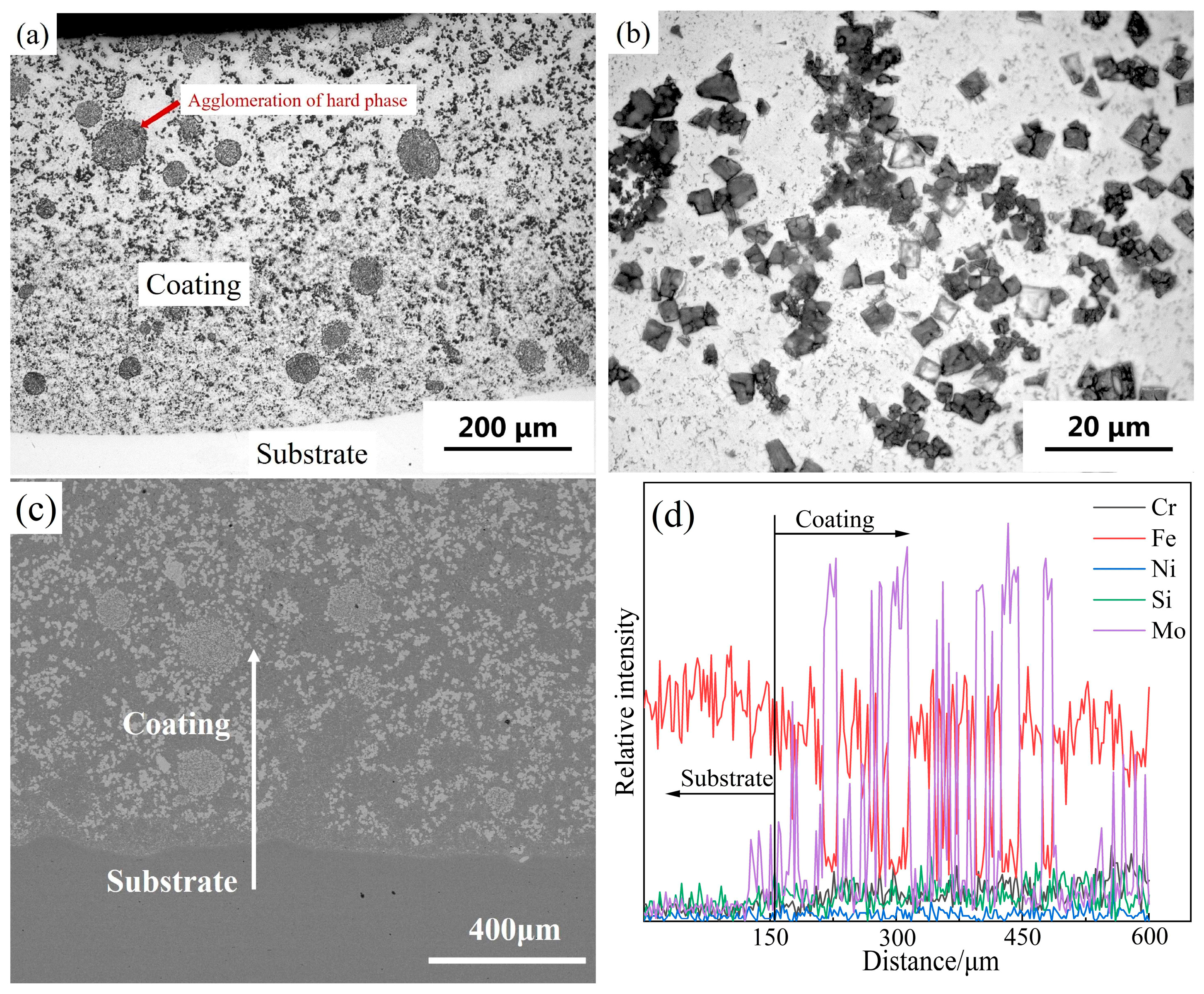
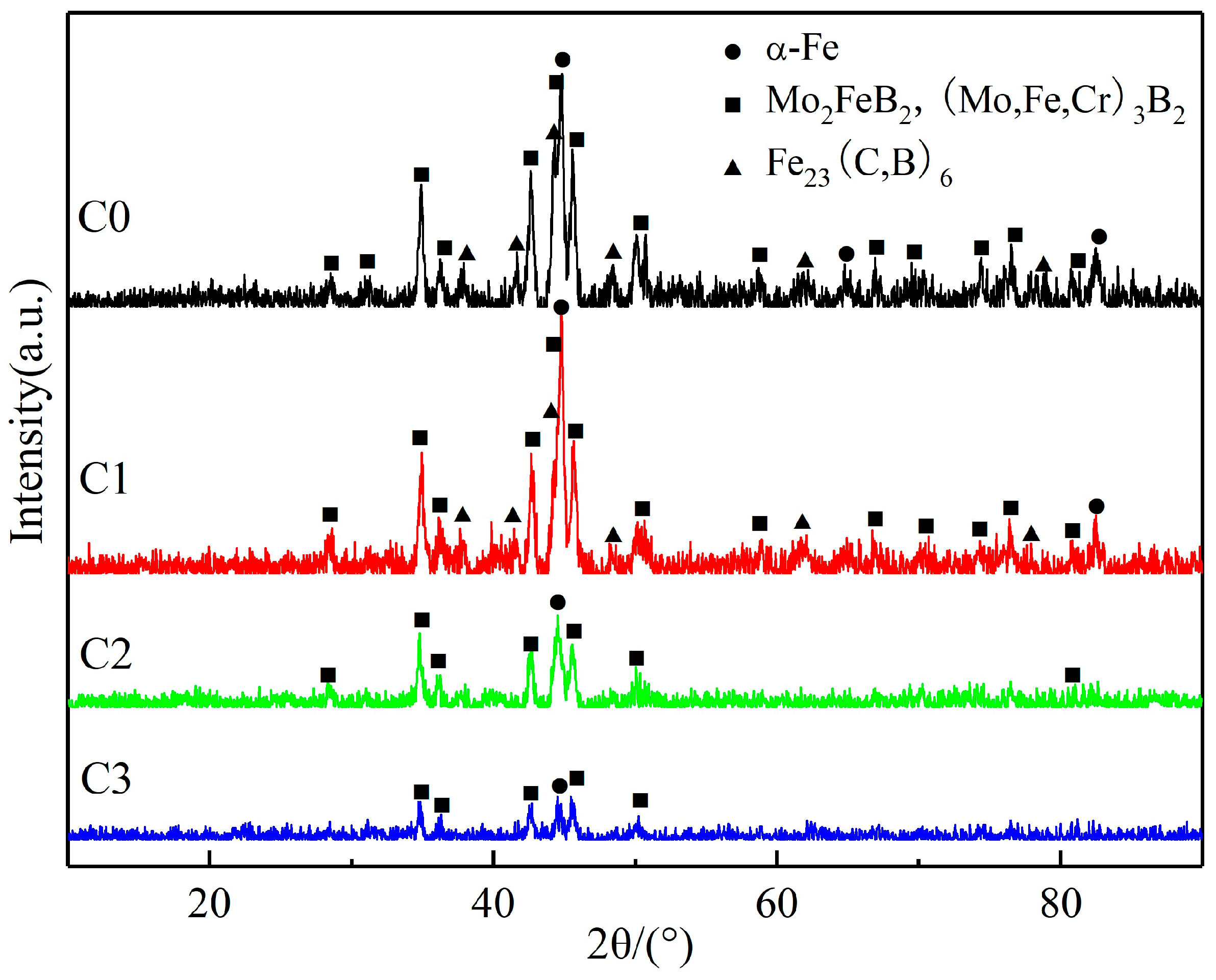



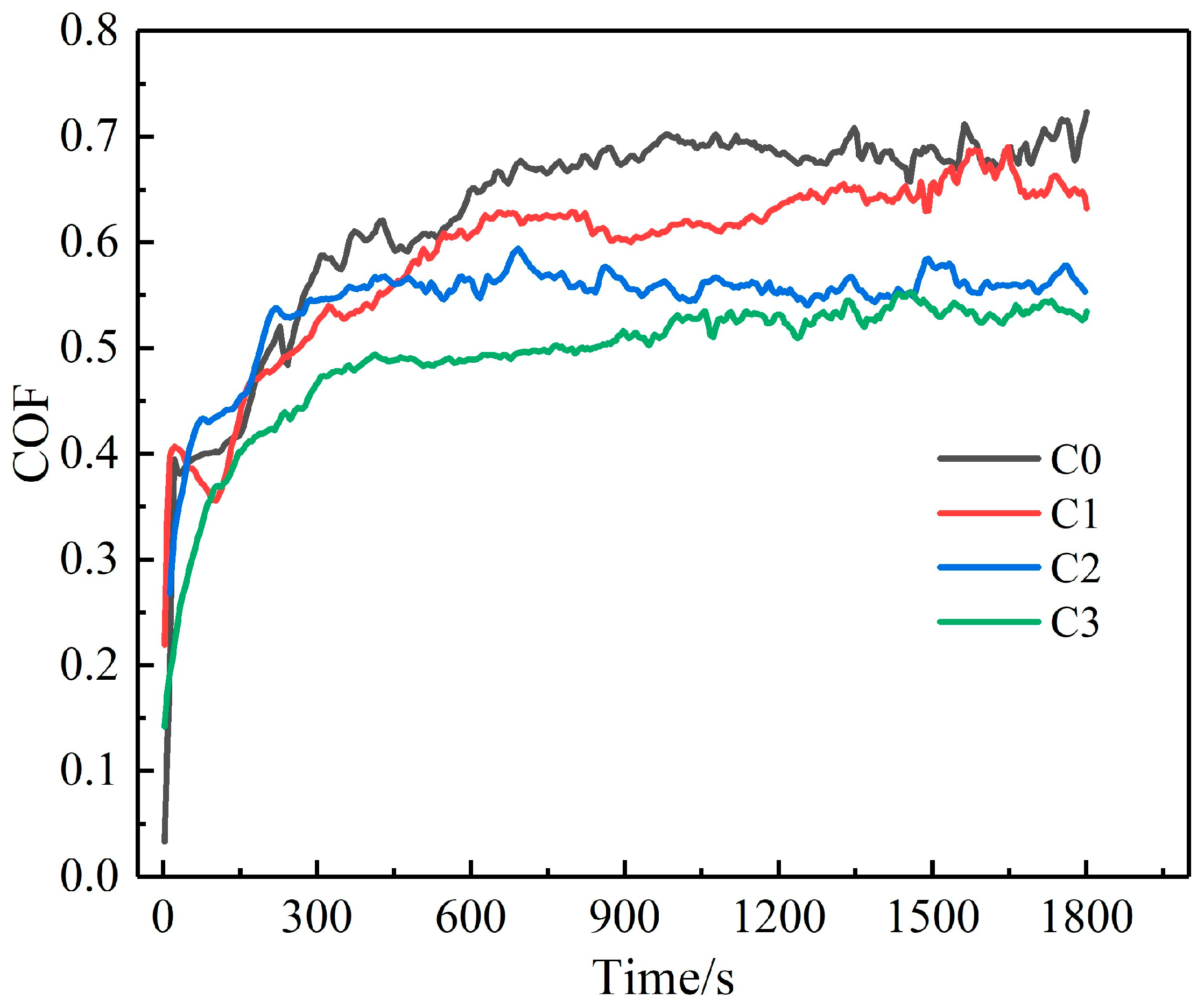
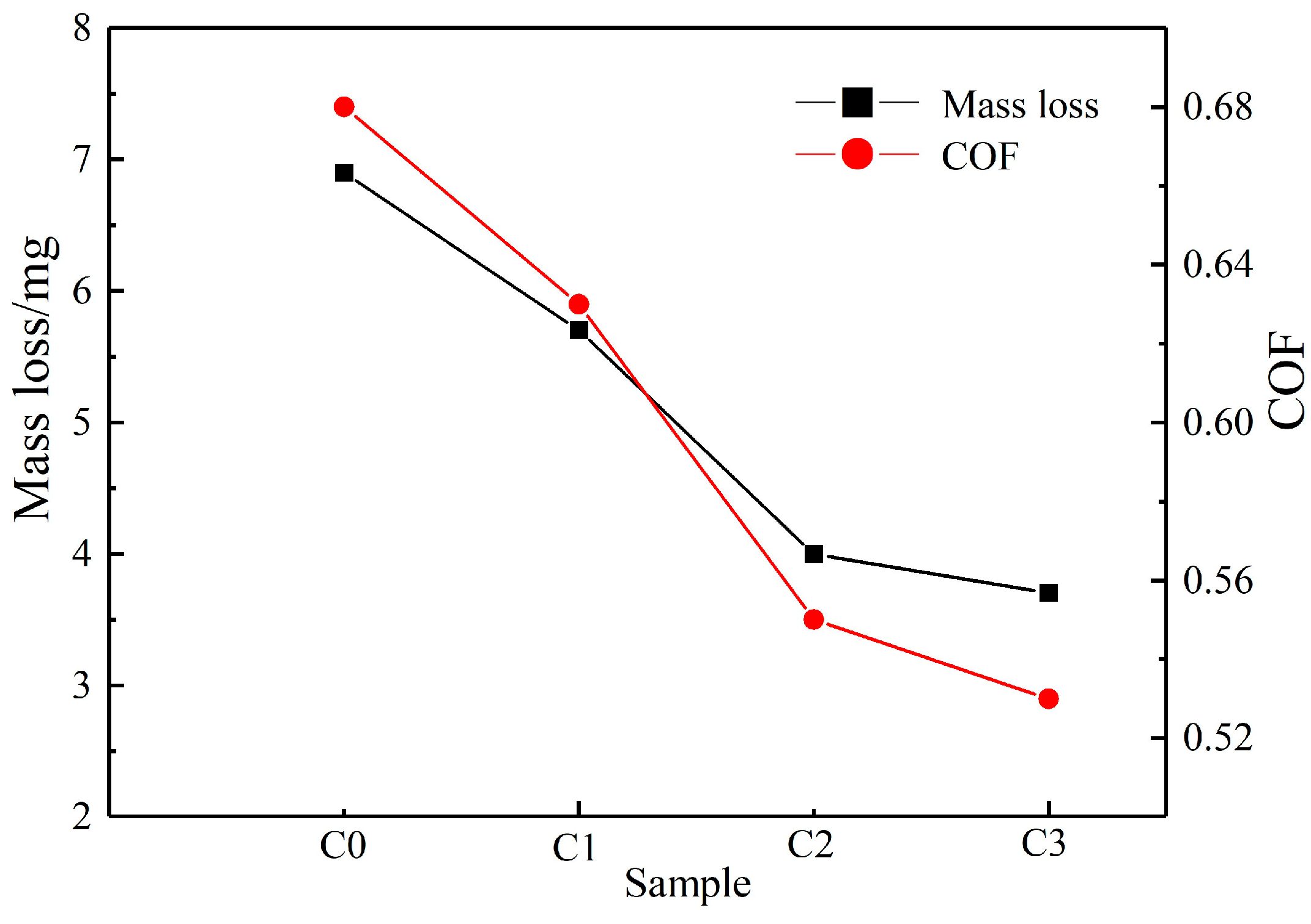
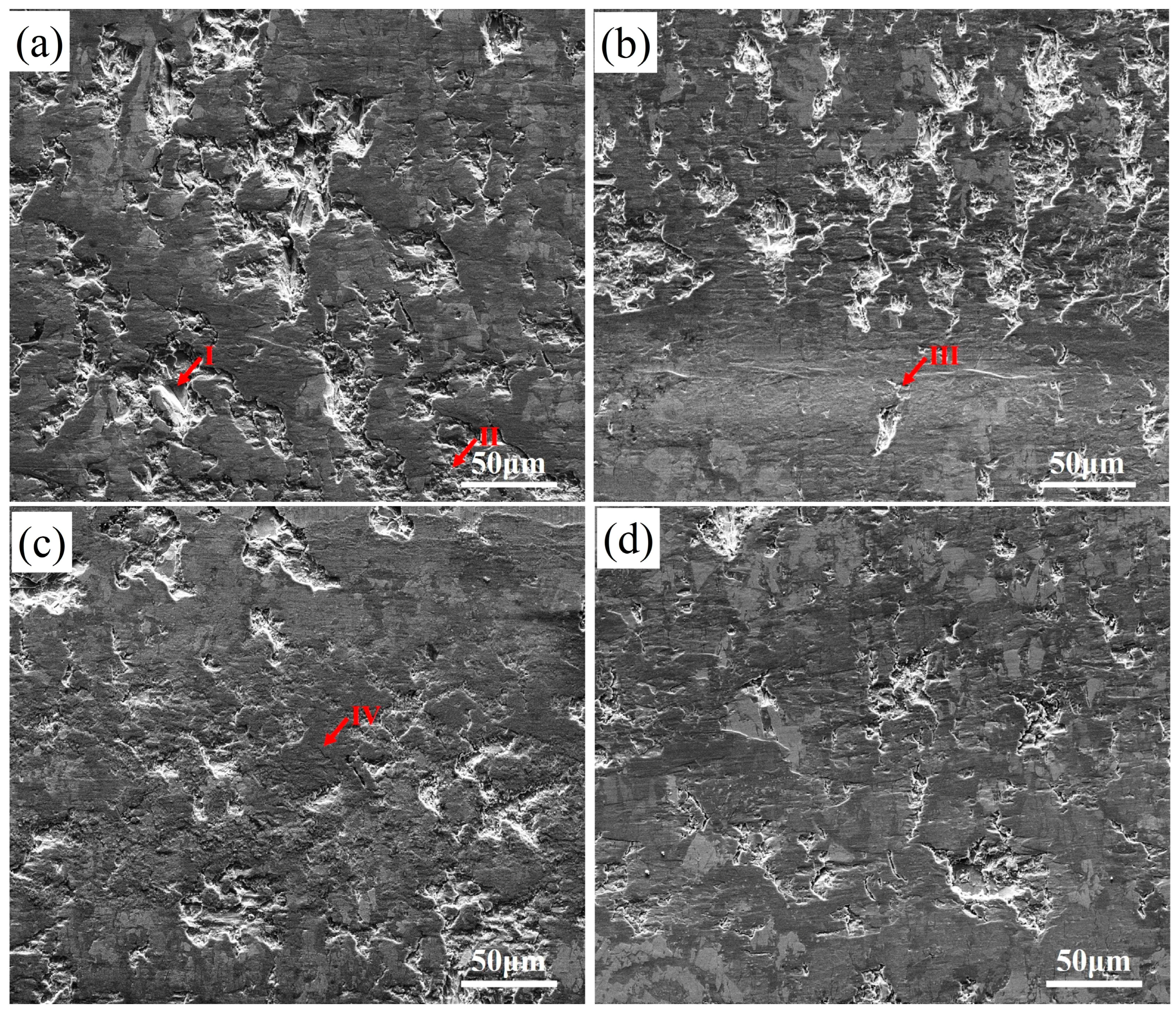
| C | Si | Mn | Cr | Mo | V | P | S | Fe |
|---|---|---|---|---|---|---|---|---|
| 0.35~0.40 | 1.13~1.20 | 0.40~0.50 | 4.50~4.80 | 1.30~1.50 | 0.80~1.00 | ≤0.03 | ≤0.03 | Rest |
| Mo | FeB | Cr | SiC | Ni | Fe |
|---|---|---|---|---|---|
| 18~25 | 10~15 | 5~8 | 0.3~0.6 | 1~1.5 | Rest |
| Nozzle Height (mm) | Voltage (V) | Non-Transferred Arc (A) | Transferred Arc (A) | Plasma Ar Gas Flow (L/min) | Powder Ar Gas Flow (L/min) | Powder Feeding (g/min) | Surfacing Speed (mm/min) |
|---|---|---|---|---|---|---|---|
| 10 | 30 | 11 | 90 | 1.0 | 4 | 10 | 80 |
| Point | Weight% | Atomic% | ||||||||
|---|---|---|---|---|---|---|---|---|---|---|
| Mo | Fe | Cr | Ni | Si | Mo | Fe | Cr | Ni | Si | |
| 1 | 1.13 | 41.03 | 1.97 | 3.10 | 1.51 | 0.96 | 83.10 | 3.87 | 5.97 | 6.10 |
| 2 | 13.00 | 7.64 | 2.57 | 0.78 | 0.27 | 39.30 | 39.67 | 14.35 | 3.88 | 2.80 |
| 3 | 1.41 | 57.20 | 2.28 | 4.01 | 1.94 | 1.19 | 83.24 | 3.92 | 5.56 | 6.08 |
| 4 | 24.93 | 32.26 | 3.05 | 1.67 | 1.01 | 26.97 | 59.91 | 6.09 | 2.94 | 4.09 |
| 5 | - | 52.01 | 1.69 | 3.87 | 3.41 | - | 80.88 | 2.83 | 5.73 | 10.56 |
| 6 | 38.95 | 15.34 | 5.65 | - | - | 51.43 | 34.81 | 13.76 | - | - |
| 7 | - | 53.68 | 2.04 | 4.01 | 2.56 | - | 82.57 | 3.73 | 5.87 | 7.83 |
| 8 | 41.47 | 14.68 | 5.42 | - | - | 54.07 | 32.88 | 13.05 | - | - |
| 9 | - | 45.92 | 7.95 | - | - | - | 84.32 | 15.68 | - | - |
| 10 | - | 46.61 | 7.34 | - | - | - | 85.53 | 14.47 | - | - |
Disclaimer/Publisher’s Note: The statements, opinions and data contained in all publications are solely those of the individual author(s) and contributor(s) and not of MDPI and/or the editor(s). MDPI and/or the editor(s) disclaim responsibility for any injury to people or property resulting from any ideas, methods, instructions or products referred to in the content. |
© 2025 by the authors. Licensee MDPI, Basel, Switzerland. This article is an open access article distributed under the terms and conditions of the Creative Commons Attribution (CC BY) license (https://creativecommons.org/licenses/by/4.0/).
Share and Cite
Zhang, H.; Hu, Y.; Zhang, Y. Effect of Quenching Temperature on Microstructure and Wear Resistant Properties of Mo2FeB2 Cermet Coating. Lubricants 2025, 13, 233. https://doi.org/10.3390/lubricants13060233
Zhang H, Hu Y, Zhang Y. Effect of Quenching Temperature on Microstructure and Wear Resistant Properties of Mo2FeB2 Cermet Coating. Lubricants. 2025; 13(6):233. https://doi.org/10.3390/lubricants13060233
Chicago/Turabian StyleZhang, Hao, Yongqi Hu, and Yang Zhang. 2025. "Effect of Quenching Temperature on Microstructure and Wear Resistant Properties of Mo2FeB2 Cermet Coating" Lubricants 13, no. 6: 233. https://doi.org/10.3390/lubricants13060233
APA StyleZhang, H., Hu, Y., & Zhang, Y. (2025). Effect of Quenching Temperature on Microstructure and Wear Resistant Properties of Mo2FeB2 Cermet Coating. Lubricants, 13(6), 233. https://doi.org/10.3390/lubricants13060233





